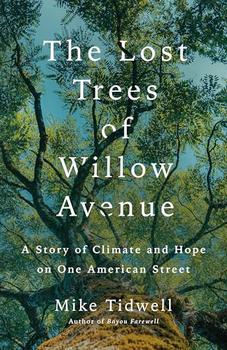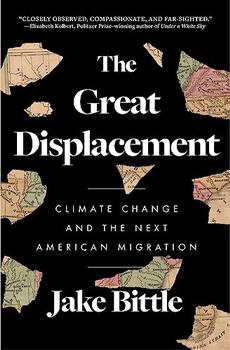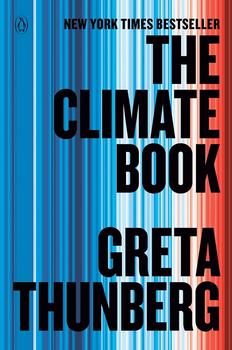Summary | Excerpt | Reviews | Beyond the book | Read-Alikes | Genres & Themes | Author Bio

A Story of Climate and Hope on One American Street
by Mike TidwellIt starts with a murder mystery of sorts: what is killing the trees on a certain street in the Washington, DC suburb of Takoma Park, Maryland? The investigation sparks climate activist Mike Tidwell's obsession with spotting evidence of climate breakdown around his city. Along the way, he also discovers glimmers of hope, in the form of local scientists working on climate mitigation projects and residents coming together to make their neighborhood more resilient.
Tidwell, who moved to Takoma Park in 1991, has observed severe climatic changes in the intervening decades, including less snow, more storms, suffocating heat, and wetter summers. In general, the weather has become more unpredictable and extreme; nearby Ellicott City had two "one-thousand-year flood" events within two years (2016 and 2018). The deer population has also exploded, leading to more ticks surviving the newly mild winters and subsequently infecting humans. Tidwell is one of several in his neighborhood struggling with chronic Lyme disease after tick bites.
But the most visible effect of climate change on the author's street is the disappearance of many trees—between 2019 and 2021 alone, 1200 were lost across the city. Several of Tidwell's neighbors have had to order oak trees cut down, the giant stumps remaining as reminders of former majesty. These oaks had previously provided food and habitat for 500 species, as well as shade, beauty, and well-being for people—it's ten degrees cooler under a mature oak. Tidwell learns that, due to increasing rainfall, oak roots are being attacked by the water mold phytophthora. In response, ailing trees release a chemical distress signal that attracts ambrosia beetles, which drill into the trunk. By the time sawdust-lined holes in the bark appear, it's too late. Every dying tree requires complicated dismantling by skilled arborists. Every loss provokes grief.
The early chapters set the scene, while the rest of the book is a month-by-month picture of the state of the environment over the course of the year 2023, through the lens of Takoma Park. Many of Tidwell's neighbors are eco-conscious and have electric cars and solar panels. He vacillates between optimism about people's engagement and gloom as abnormal heat is followed by Canadian wildfire smoke. It's grimly appropriate that he embarks on this project not knowing that 2023 will go down in history as the planet's hottest year (at the time—2024 proved even hotter).
Curious about what actually happens to his city's dead trees, Tidwell teams up with neighbor Ning Zeng, a professor of climate science at the University of Maryland. Together they visit Camp Small, a sort of tree graveyard in Baltimore. The yardmaster tells them he only sells 15% of what comes in, as mulch or timber. He's inundated with trees, especially white oaks (the state tree of Maryland). Zeng's research focuses on burying dead trees in clay so they don't release their carbon into the atmosphere. One thread of the book follows up on his efforts to cut through red tape and find farmland where he can bury five thousand tons of timber.
Tidwell also surveys other climate mitigation strategies (see Beyond the Book) and meets with environmentally minded local politicians. His Maryland House of Delegates representative, Lorig Charkoudian, accompanies him to view a Virginia offshore windmill. In his own community, he gets involved in several grassroots projects. With Barbara, a Sierra Club activist, he goes hunting for methane leaks, which harm trees. Making the best of the resultant loss of shade from tree removal, he and his neighbor Dorothy create miniature roadside gardens to grow vegetables. Around the neighborhood, people plant new trees such as cypresses and swamp oaks that can cope with waterlogged conditions. He recalls the success of a 2021 volunteer campaign to cut down English ivy and other invasive vines choking trees.
The narrative is wide-ranging, covering many aspects of the climate crisis. With his journalistic eye for detail, Tidwell captures real people and scenes in an engaging way. At times, however, the content is overly technical. Moreover, climate science and policy are so fast-changing that in places—particularly since the January 2025 inauguration of the second Trump administration—the policies and approaches Tidwell discusses are out of date already.
Although the book's scope might initially seem overly provincial, the strategy of understanding global phenomena through a local microcosm is very effective. I had a personal reason for wanting to read this: I was born in Takoma Park. Although I've now lived in England for 20 years, I hear from my sister about Maryland's weather, such as the rise in tornadoes, which never happened when we were children. Wherever we live, all of us will have more examples of crazy weather, as former rarities become commonplace. It may be sobering to sit with the facts of climate breakdown while reading a book such as this, but knowledge empowers collective action.
![]() This review
first ran in the April 9, 2025
issue of BookBrowse Recommends.
This review
first ran in the April 9, 2025
issue of BookBrowse Recommends.

If you liked The Lost Trees of Willow Avenue, try these:

by Jake Bittle
Published 2024
The untold story of climate migration—the personal stories of those experiencing displacement, the portraits of communities being torn apart by disaster, and the implications for all of us as we confront a changing future.

by Greta Thunberg
Published 2024
We still have time to change the world. From Greta Thunberg, the world's leading climate activist, comes the essential handbook for making it happen.
If passion drives you, let reason hold the reins
Click Here to find out who said this, as well as discovering other famous literary quotes!
Your guide toexceptional books
BookBrowse seeks out and recommends the best in contemporary fiction and nonfiction—books that not only engage and entertain but also deepen our understanding of ourselves and the world around us.